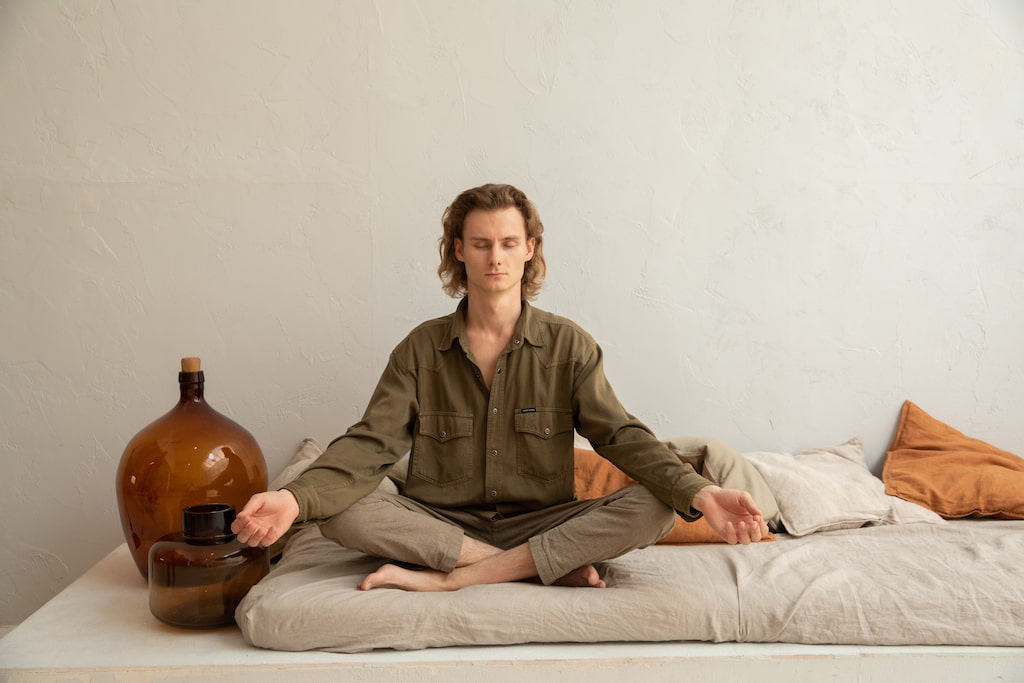Calm Amidst the Chaos: Finding Inner Stillness During Stressful Times

The human journey is like a beautiful tapestry; our individual stories comprised of countless threads, woven together to create the whole of our experience. From the front, we see a colorful, vibrant work of art. From the back, we see it’s imperfections–frayed pieces, overlapping threads, knots holding it together, mistakes hidden from the eye of the observer. To me, it’s the perfect analogy for the masterpiece of our lives, each with both good days and bad, joys and sorrows, peace of mind and heaviness of heart. We need the tangled stitches as much as the perfectly placed threads to bring shape, meaning, and structure to our work of art.
We all prefer when things are working in our favor, but an essential part of life mastery is learning to ride the storms–staying calm and anchored amidst the chaos. When life disrupts our peace of mind and presents us with challenges, as it inevitably will, there is always a tendency to turn our backs in resistance. Fear, pain, loss, and grief are unpleasantries that nobody wants to feel, so rather than face the stress and anxiety they may cause, we often push them away in the hopes they’ll disappear. The problem is that when we resist, we come into conflict with our present moment reality, and we actually give these feelings power.
The road to peace begins when we can face these feelings, allowing them to rise and fall, to come and go, all without the need to control. If we can approach them, even in the most difficult of circumstances, with a willingness to be with our experience, in total acceptance of what is, we open a possibility of landing peacefully in the present moment of our lives. In other words, we must continue to weave with patience and resilience, trusting in the bigger picture.

Realize Your Emotions
Acceptance isn’t about resignation. Quite the contrary, it is active and engaged. It doesn’t mean we don’t desire for our experience to be different in the near future. It simply means that we’re acknowledging our state of being in the here-and-now. When we accept–when we can admit that we are scared, anxious, overwhelmed–we give voice to our difficult feelings. Creating space for them to rise to the surface in their full expression, with bravery and honesty, is the first step in allowing them to move through us. Where there is movement, there is the hope of liberation. Releasing our grip on these feelings is an empowering experience because it enables us to become less identified with them. It shows us an unwavering stability beneath the fluctuations of our minds, a distance from our thoughts, that can be very grounding during times of stress.
Realize your Inner Source
Developing reliable practices that nurture us during moments of internal conflict is essential for self-care. When I sense myself spiraling and know I need to prioritize my own support, I find a quiet place and I take refuge in the breath. It needn’t be anywhere special. Stress and anxiety don’t wait until it’s convenient to show up. Your sanctuary can be an airport bathroom, in your car on the side of the highway, or behind the locked door in your bedroom, away from your children.

The Practice
1) With no sense of urgency, settle into a comfortable seat or lay down on my back. Close your eyes, arrive in your body, and settle in with a mindful check-in. Notice what your feeling and what is in your awareness. Remind yourself to give complete permission to be exactly where you are, to relinquish a bit of control and let go of the desire for things to be different.
2) Place your right hand on your belly, the left over your heart, and bring some awareness to the movement of your breath. At first, simply observe. Watch the speed, depth, and rhythm. Notice where the breath is prominent (perhaps the nose or chest). Then, slowly shift to nasal breathing, and allow it to expand with ease throughout your torso. Feel the breath lift the ribs and belly to meet your hands on the inhale and soften on the exhale. Feel the air fill out your side and back body on the inhales. Let the body get heavy and soft on the exhales. Spend several minutes riding the waves of full-body breaths, allowing the rocking sensation to comfort you.
3) Staying mindful of the movement of breath, take a moment to reflect on what wants to be expressed. Check in with the source of your internal conflict, and notice if there is something your resisting and how this is disturbing your inner peace. Give space for the full expression of your feelings, thoughts, and emotions. Notice how this shows up in your body and stay present with the sensations. Allow for intensity as they arise on the inhales, and watch them slowly dissipate with every exhale. Continue this practice of watching them rise and fall with complete acceptance. Rather than “letting them go”, simply “let them be”
4) Once the mind has become quiet, invite stillness and spaciousness in your inner landscape. Imagine a state of mind, where, at any moment, you can easily access a reservoir of peace within. An environment where a sense of calm flows naturally and which you can return to quickly when you fall from center. Allow this feeling to flood the body and get lost in waves of relaxation.
5) When you feel ready, gradually, transition awareness back to the breath–deep inhales and complete exhales through the nose. Bring focus to your heart space, offering yourself a moment of love and compassion. Once again, feel the hands rising and falling with the movement of the breath. Feeling held and supported and acknowledged. As you end your meditation, open the eyes.
May this practice be a source of mental support and lead you back to moments of rest and ease. Please let us know if you’ve found it help useful.





